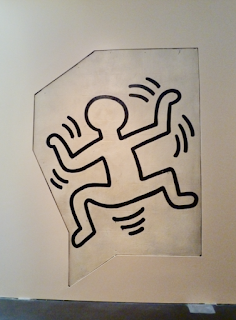 |
Radiant Baby motif.
|
Late last month DH and I got on a plane for the first time in a year and a half. Masked from the time we stepped into our Uber in Boston until we left the Denver terminal, we flew to Colorado to visit family and took in this exhibit.
In the early 1980's artist Keith Haring painted designs on a stairwell at Grace House, a Catholic-run youth center in Manhattan. In 2016, the church which operated the center decided to sell the building and removed thirteen images, no easy feat as these black-and-white line drawings were painted on concrete block walls. Removing valuable artwork from walls is not without precedent, but in this case it was the institution's decision. After removal, the segments were sold at auction and purchased by an anonymous buyer. The fragments are on display at the Museum of Contemporary Art Denver, through August 22.
 |
Exhibit includes original stairwell utilities.
|
 |
The images are slightly larger-than-life.
|
Haring painted these images right around existing doors, a mailbox, and other stairwell elements, some of which are included with the fragments.
 |
| Haring responded to elements of the stairwell. |
|
|
 |
Fire extinguisher sign from original stairwell.
|
From the exhibit wall text:
After experimenting with collage and automatic drawing, Keith Haring (b. Kutztown, PA, 1958, d. 1990) developed a direct and unmediated approach to artmaking, which Grace House Mural vividly reflects. This project makes clear how the strength of his work lied in his bold and flexible use of line. A fluid, confident, and jubilant application of paint on the wall pulsates with energy and vitality. Haring's graphic style is expansive, extending beyond a frame and stretching into our space; it is meant to be in conversation with its viewer.
Grace House Mural was designed specifically to inspire and elevated the spirits of some of New York's teens and includes some of his most iconic motifs: the "Radiant Baby," "Barking Dog," and dancing figures.
 |
Barking Dog motif.
|
 |
Dancing figure.
|
At the base of some of my images you can see what look like metal tabs sticking out at the floor level. If I understand the wall text, and brief comments from a gallery attendant, correctly, the concrete blocks were sliced so as to retain only part of the face of the block. These wall slices were then mounted on some kind of metal framework, which stands on brackets visible at the base of the walls of the exhibit. It would have been fun if one fragment had been free-standing, or otherwise displayed in such a way as to demonstrate these conservation efforts.
Somewhere in transit between New York and Denver some cracks appeared, sadly. This is most easily seen in the image below. This must have been very challenging conservation project.
 |
A few fragments developed cracks.
|
However, at least the mural survived, even if removed from its narrative flow. Very few of Haring's murals are extant.
Below, more dancing figures. They just vibrate with motion and joy.
 |
Exterior, Museum of Contemporary Art, Denver.
|
The MCA Denver doesn't have a permanent collection but does feature a rooftop cafe with fun views of downtown Denver, and a small but well-curated gift shop.





















































